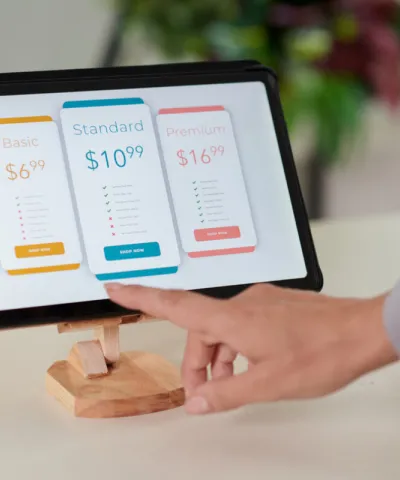What is variable pricing?
Variable pricing, also known as dynamic pricing or surge pricing, offers flexibility to adjust prices based on various factors. These factors include demand, supply, competition, or even external elements, like weather or time of day.
By applying this strategy, you can optimize your revenue by charging different prices to different customers at different times. This enables you to maximize profits, manage inventory, attract customers during off-peak times, and remain competitive in the market.
Which industries apply variable pricing?
Airlines are the trailblazers in variable pricing and have been employing it for the longest time. If you've ever reserved a flight and monitored prices over a set period, you're aware that prices are constantly fluctuating. It usually becomes pricier when you reserve near the actual flight date or when the flight is nearly at capacity. Ticket pricing is a good example of where variable pricing works well.
In today's world, fluctuating pricing is not unusual, even in the realm of sports. The New York Mets began implementing variable pricing for their event tickets as early as 2016, considering factors such as the week, weather, opponent, and numerous other elements when determining supply and demand. Other sports teams, cinemas, museums, and event parks have introduced variable pricing. As usual, some will pioneer the market, while others will trail behind.
Apart from ticket costs, any business that processes transactions online are one step ahead of businesses that operate "offline". Firms like Uber can manipulate their pricing in real time due to their access to real-time data. In Uber's scenario, this allows them not only to impose higher rates but also to draw more drivers onto the roads during high-demand periods. Hence, through flexible pricing, they can effectively manage both supply and demand.
Advantages of variable pricing
- Optimizes revenue by charging different prices to different customers at different times
- Helps manage inventory effectively
- Attracts customers during off-peak times
- Enables remaining competitive in the market
Disadvantages of variable pricing
A major factor contributing to the failure of variable pricing is the lack of customer acceptance.
If customers do not accept the price steering criteria, there’s a strong chance the move will backfire. This puts the company’s reputation at risk.
A well-known instance is Coca-Cola, which attempted to modify the cost of a Coke can at vending machines depending on the external temperature. Customers viewed it as unjust to pay a higher price during warm weather. However, it’s acceptable to pay more depending on location, e.g., at the airport vs. a supermarket.
A further hazard of variable pricing is the absence of pricing expertise.
If your pricing strategy is reliant on instinct or the cost-plus approach, you're likely to erode profit margins with peak pricing. Proficiency in data management and advanced analytical abilities are essential for variable pricing. If you're unable to promptly identifying shifts in supply and demand, it's impossible to make it work. This is applicable to most businesses that were traditionally "offline" and not originally established in the digital realm.
Customers may learn to game your system.
Even if you successfully implement variable pricing and your data appears promising, there's a chance that your customers will begin to see through the workings of your system and start to "game" it. They may start to wait for the lowest price, and more critically, concentrate solely on the price. Conversely, to prevent a decrease in prices, the conversation you should be having with your customers should revolve around value, not price.
How to succeed with variable pricing strategies
Begin with the basics
Start by establishing simple rules around a minimal set of variables. As you accumulate more experience, data, and tracking capabilities, you can gradually introduce more complex rules and additional variables.
Prioritize specific goals, rather than optimization
Your pricing strategy should be driven by your specific goals (such as attendance, mix, revenue, etc.), and your focus should be on achieving these goals, rather than on optimization alone.
Leverage relative comparisons to your benefit
You need to determine which pricing approach is more effective in your specific context and market. Do you aim for the highest possible prices with variable discounts? Or do you prefer to set lower prices and then apply premiums and surcharges?
Avoid allowing consumers to dictate prices
Prices are initially a product of imagination. Keep that in mind! In essence, no sports event possesses a set inherent worth. It’s worth is determined by the figure (price) you attribute to it and the perspective you offer consumers to interpret that figure.
If you provide individuals with the mechanics of a game, or a route to reduced prices, they will grab this chance and transform your "imaginary" into a "reality" that you may not appreciate.
Regardless if you're a physical store with digital price labels, a production firm, or an internet-based business - the effectiveness of fluctuating pricing hinges on proper implementation.
How Simon-Kucher can help
We at Simon-Kucher are the experts when it comes to assisting companies in optimizing their pricing strategies. Our sophisticated pricing models and data analytics help companies dynamically adjust the price of their products or services based on various factors such as demand periods, competitor pricing, and customer segments.
By identifying optimal price points during peak demand periods and offering tailored pricing models for different customer segments, we enable companies to maximize revenue and profitability while maintaining competitiveness in the market.
Whether it's implementing time-based pricing strategies to capitalize on demand fluctuations or segment-based pricing models to target specific customer groups, we provide comprehensive solutions to ensure that companies extract maximum value from their offerings while meeting customer expectations.
Reach out to us today!



